Kinetic theory has got more applications in daily life, in most of the tools and apparatus we use in our activities. This articles will focus on the major application.
Table of Contents
The Rates of Diffusion and Kinetic Theory
Diffusion is the process by which the molecules of one substance mix with those of another as a result of their motionMotion is the act of changing location from one place to ano... More. The substances move freely from a region of high concentration to a region of low concentration at their own pace. The rate of diffusion depends on the temperature and the density of the substances involved as proved in experiment 1.1 and 1.2 below.
Experiment 1.1: Diffusion in gases
Aim: to demonstrate the diffusion in hydrogen
Requirements: hydrogen gas, porous jar, glass tube, coloured water, clamp and stand,
Hydrogen gas passes quite easily through earthenware which is porous. Arrange the apparatus as shown in the figure below. Introduce hydrogen into a vessel surrounding porous jar. What do you observe?
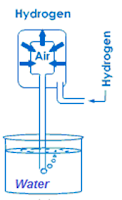 |
| Diffusion of hydrogen |
Observation:
The bubbles of the gas start to escape through the water: The hydrogen will diffuse through the porous jar and increases the gas pressure in the jar and this will cause some of the gas to bubble out. Air molecules will diffuse out of the vessel at the same time as the hydrogen molecules diffuse in but because the air molecules are large and heavier they diffuse out at a much slower rate.
Conclusion: The rate of diffusion in gases depends on its density.
Air is a uniform mixture of various gases because of diffusion. However, diffusion does not only take place in gases, it even occurs in liquids as well. If convection currents and stirring are avoided, it can be demonstrated that diffusion in liquid is quite slow using the following setup.
Experiment 1.2: Diffusion in liquids
Aim: To show diffusion in water
Materials: beaker, water, dropper, copper sulphate (CuSO4)
Procedure:
Fill a gas jar with water. Place a thistle funnel into it so that it extends to the bottom of the jar and carefully pour a solution of copper sulphate until the bottom of the jar is filled to a height about one centimetre. Let the jar stand undisturbed for a few days. What do you observe?
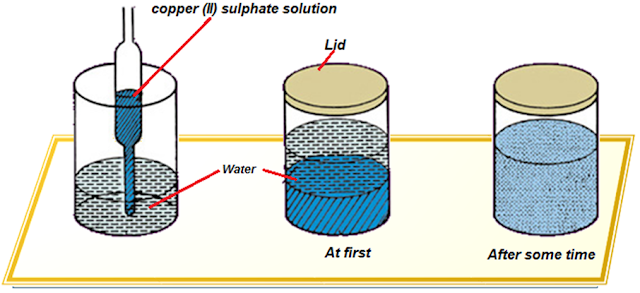 |
| Diffusion in a liquid |
Observation: You will observe an upward diffusion of the blue copper sulphate against gravityGravity, or Gravitational Force is the force of attraction b... More.
Conclusion: The rate of diffusion in liquid depends on the temperature.
The diffusion in fluids can be explained using the kinetic theory model.
· When diffusion takes place, molecules move from one substance to another to fill up the empty spaces.
· The spaces between the molecules are such that molecules are able to pass through them.
· The continuous movement of the molecules ensures a thorough mixing of the substances as they collide.
· When temperature is increased, the kinetic energyEnergy is the property of matter and radiation which is mani... More increases through the increased speeds of molecules and consequently, the rate of diffusion increases.
BROWNIAN MOTIONMotion is the act of changing location from one place to ano... More
In 1827 Robert Brown was studying pollen grain suspended in water using a microscope, he was very surprised to observe that they were in a state of continuous random motionMotion is the act of changing location from one place to ano... More. He could not account for this movement, but later scientists discovered that the movement of the pollen grain was due to the collision of the water molecules against the pollen grains.
If you observe smoke particles in air, you will notice that they experience similar movement. As a result of such observations, scientists concluded that the molecules of liquids and gases are in a state of constant, random motionMotion is the act of changing location from one place to ano... More, an idea known as the “kinetic theory of matter”
Experiment 1.3: Brownian motionMotion is the act of changing location from one place to ano... More
Aim: To demonstrate Brownian motionMotion is the act of changing location from one place to ano... More in air/ a smoke cell
Materials: glass (smoke) cell, optical microscope, converging lens, a lamp/ torch lamp
Procedure:
Set up apparatus as shown in the figure below; a small glass cell in which smoke has been trapped is view through a microscope. A converging lens or glass rod is used to focus the light from a lamp into the glass cell.
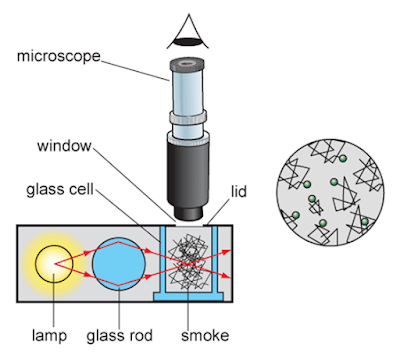 |
| Observation of Brownian motionMotion is the act of changing location from one place to ano... More |
Observation:
When the light strikes the smoke particles it is scattered and the smoke particles are observed as bright specs of light. They are also seen to be moving about in a zig-zag manner.
Conclusion:
This zigzag movement is due to the collisions of the smoke particles with invisible air molecules that are also moving about randomly in the smoke cell. The zigzag pattern of movement is illustrated in figure below.
 |
| The zigzag movement of the smoke particles |
EVAPORATIONEvaporation is the change of a liquid into a gas at the surf... More
EvaporationEvaporation is the change of a liquid into a gas at the surf... More is the change of a liquid into a gas at the surface. It occurs at any temperature but occurs more rapidly at higher temperatures because heat imparts more kinetic energyEnergy is the property of matter and radiation which is mani... More to the molecules and they escape from the surface faster.
Increased gas pressure on the surface of the liquid reduces the rate of evaporationEvaporation is the change of a liquid into a gas at the surf... More because more collisions occur between the evaporating liquid molecules and the gas molecules, resulting in some of the evaporated liquid molecules bouncing back into liquid.
Some factors increase the rate of evaporationEvaporation is the change of a liquid into a gas at the surf... More namely:
– Increase in temperature: If we observe the wet clothes, we will notice that on a warm day, they dry faster than on a cold day. This is because more particles of the water have enough energyEnergy is the property of matter and radiation which is mani... More to escape.
– Increase in surface area: Water in a puddle on the road will dry more quickly than water in a cup. This is because more water molecules in the puddle are close to the surface and escape in bigger number than in the cup.
– Air blowing across the surface: When a day is windy, the clothes dry faster than when it is quiet or you can dry your wet hand by getting them closer to the fan. This is because the moving air carries escaping water molecules away from the liquid, preventing them from bouncing back into the liquid as result of air pressureAir pressure is the pressure exerted by the atmosphere More over the liquid.
– Reduction of humidity: when air contains more water vapour, it is said to be very humid. Wet clothes will take longer to dry in very humid air because molecules in the water vapour return to the liquid almost at the same rate as water molecules escape from it.
During the evaporationEvaporation is the change of a liquid into a gas at the surf... More process, the molecules that escape from the liquid are the most energetic ones. The average kinetic energyEnergy is the property of matter and radiation which is mani... More of those that remain is therefore reduced, and the temperature reduces. This is cooling by evaporationEvaporation is the change of a liquid into a gas at the surf... More.
COOLING EFFECT OF EVAPORATIONEvaporation is the change of a liquid into a gas at the surf... More
EvaporationEvaporation is the change of a liquid into a gas at the surf... More results in a general cooling of the liquid. This cooling is brought about by the lowering of the overall kinetic energyEnergy is the property of matter and radiation which is mani... More of the liquid as the more energetic molecules escape from the surface.
If energyEnergy is the property of matter and radiation which is mani... More is supplied to the liquid molecules (for example by heating), the rate of evaporationEvaporation is the change of a liquid into a gas at the surf... More increases. If this energyEnergy is the property of matter and radiation which is mani... More comes from the surroundings, then the surroundings lose energyEnergy is the property of matter and radiation which is mani... More and experience a drop in temperature. The cooling effect of evaporationEvaporation is the change of a liquid into a gas at the surf... More can be demonstrated by the following experiment:
Experiment 1.4: Cooling effect of evaporationEvaporation is the change of a liquid into a gas at the surf... More.
Aim: To demonstrate the cooling effect of evaporationEvaporation is the change of a liquid into a gas at the surf... More.
Requirements: a small beaker, ether, wooden block, water, glass tube
Procedure:
Place a small beaker, about one third full of ether, on a flat piece of wood which has a layer of water on it. Place a glass tube obliquely into the beaker to allow air in the beaker.
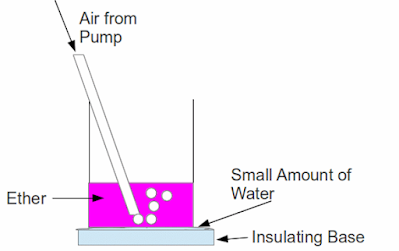 |
| Cooling by evaporationEvaporation is the change of a liquid into a gas at the surf... More |
Observation:
Air is bubbled through the ether and effectively increases the surface area of the liquid and allows a lot more evaporationEvaporation is the change of a liquid into a gas at the surf... More to take place. As the evaporationEvaporation is the change of a liquid into a gas at the surf... More continues, the water between the beaker and wooden block will gradually start to freeze and the beaker will stick to the wooden block. Water droplets will also form on the outside of the beaker.
Explanation:
The energyEnergy is the property of matter and radiation which is mani... More required for this increased rate of evaporationEvaporation is the change of a liquid into a gas at the surf... More is drawn from the beaker, the water and the wooden block
Water droplets form on the outside of the beaker due to condensation of water vapour from the surrounding air coming into contact with the beaker.
The cooling effect of evaporationEvaporation is the change of a liquid into a gas at the surf... More is utilised in refrigerators. A refrigerator basically transfers heat from the inside cabinet to the outside environment. The principle involves a liquid that is constantly evaporating and thereby drawing energyEnergy is the property of matter and radiation which is mani... More (or heat) from the inside of the cabinet. The transfer of the heat from the inside to the outside is quite rapid and the inside becomes very cool. Once outside the cabinet the heat is transferred to the surrounding environment through the thin tube containing the vapour and the vapour is condensed back into liquid. A pumping mechanism ensures the movement of the liquid vapour round a closed system of conducting pipes thereby keeping the same liquid flowing continually.
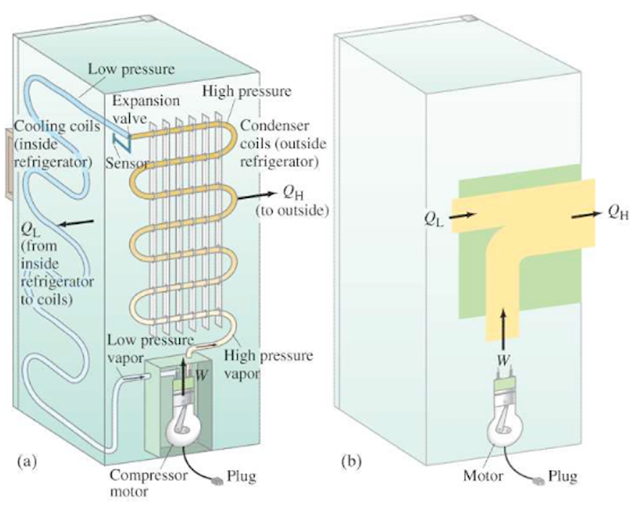 |
| Illustration of cooling process in domestic refrigerator |
The figure above represents a typical refrigerator system. The electric compressor motor forces a gas at high pressure through a heat exchanger (condenser) on the rear outside wall of the refrigerator, where QH is given off, and the gas cools to become liquid. The liquid passes from a high-pressure region, via a valve, to low-pressure tubes on the inside walls of the refrigerator; the liquid evaporates at this lower pressure and thus absorbs heat (QL) from the inside of the refrigerator. The fluid returns to the compressor, where the cycle begins again
Other Cooling effects of EvaporationEvaporation is the change of a liquid into a gas at the surf... More
Another every day application of cooling by evaporationEvaporation is the change of a liquid into a gas at the surf... More is well observed in sweating: When animals sweat, fine drops of moisture are released either through the skin or through pores on the tongue. The passage of air over these drops results in evaporationEvaporation is the change of a liquid into a gas at the surf... More which causes a cooling of the animal’s body in a similar way as described in the experiment above. Dogs, for example, remove excess heat from their bodies by panting.